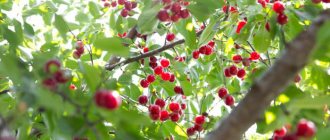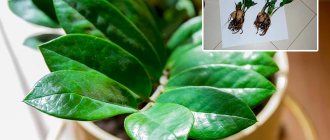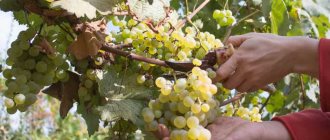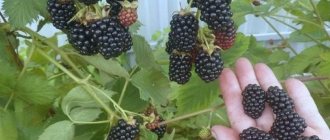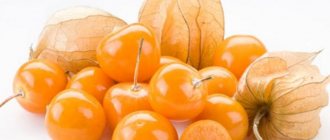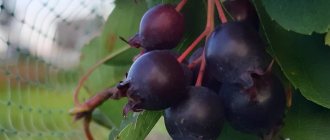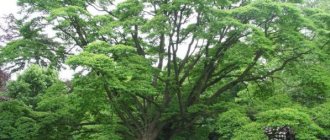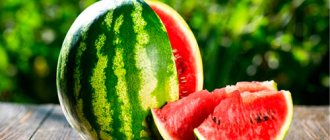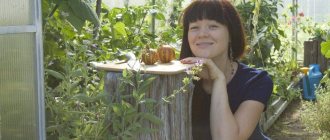What princely berries look like and description
Knyazhenika is a perennial plant native to the northern regions of Russia. The herbaceous plant of the rose family is represented by small shrubs, the height of which does not exceed 30 cm. The plant can only be found in a temperate climate zone, since such an area is most suitable for normal growth of the berry. Popular names include drupe, midday, and clearing.
The rhizome is creeping. the bulk of the roots are located below the soil surface. This way the bushes stay firmly in the ground, among moss and marsh grass. As the grass grows, the roots of the princesses become woody and turn brown. Adventitious roots receive a sufficient amount of useful substances from the soil, since they branch strongly in different directions. The maximum length of the roots reaches 20 cm inside the substrate.
The drupe has long, thin stems that are light green or reddish in color. The stems are erect, reaching a length of 30 cm. The stems are branched, with adventitious branches extending from the central shoot, on which petiole leaves are located.
Knyazhenika has large bright green leaves, which are located alternately along all stems. The leaves grow on long and thin petioles that cannot withstand the weight of the leaf itself. Therefore, the leaves are mostly downward. The leaves are trifoliate, each leaf blade has jagged edges and a pointed end. A network of veins is visible across the entire surface of the leaf plate, which seems to divide the leaf into many segments. The surface of the leaves is smooth and soft to the touch.
The plant blooms in early summer. At the same time, single buds grow at the ends of the shoots. The inflorescences do not exceed one and a half centimeters in size. Each flower has 5 petals, red or pink. The buds with flowers are shaped like daisies. The flowering of princesses lasts more than a month. Each bush can bloom differently, depending on growing conditions. Therefore, in the summer, when picking berries, you can find already ripe fruits and still flowering bushes.
After flowering, fruits appear at the site of bud formation - edible red berries, which are of particular interest to people. The fruit is a juicy berry with seeds. In shape, the fruit is similar to raspberries. A ripe berry reaches one and a half centimeters in diameter. Polyana fruits are rich red or burgundy in color. The berries taste sweet, and the smell of ripe princess is reminiscent of pineapple. Some gardeners compare the taste of princesses with raspberries.
The difference between princes and kostyaniki
In appearance, knyazhenika is very reminiscent of stone fruit berries. In this regard, the popular name for princes is drupes. However, it is important to understand that princess and stone fruit are two different berries. Both berries have the same external structure and belong to the same family. In addition, these berries live in the same areas and often grow nearby. However, their difference lies in the taste and structure of the fruit.
The fruit of the drupe is a two- or three-lobed, less often 4-5-lobed berry with a sour taste. Drupes grow throughout Russia, including in the forests of the central zone.
Unlike boneweed, princessweed is found only in northern forests and swampy areas. The berry consists of a larger number of seeds. The size of the fruit can reach the size of a raspberry. This is a rarer and sweeter berry that has a bright taste and is in demand among northerners.
What it looks like and where it grows
Common princeberry, or arctic raspberry (Rubus arcticus), is a plant from the Rosaceae family, also found under the name polyberry and midday. It is a herbaceous perennial up to 30 cm tall, with a long creeping rhizome with numerous thin shoots.
It has trifoliate green leaves and from the end of May until July bears single flowers of a dark pink hue on the tops of the shoots. The fruits of the princess are juicy multi-druplets, very reminiscent of ordinary raspberries, but more complex in color.
Garden princess berries have a pleasant pineapple aroma and sweet taste.
You can find polar raspberries in cold and temperate latitudes of the Northern Hemisphere. Knyazhenika is distributed in Finland, Norway, Sweden, Canada and the USA, as well as in the Russian tundra, Siberia and the Far East. The berry usually grows in swamps and herb meadows, near rivers and streams at an altitude of up to 1200 m above sea level.
Spreading
Knyazhenika is a berry that can only be found in the northern parts of the country. The plant prefers to live in cold climates. You can find wild berries in the northern part of America, Canada and Finland. In Russia, princess is common in Western Siberia and the Urals.
Knyazhenika is common in the forest zone. The berries grow in swampy areas, in the taiga part of the forest. In its natural environment, the plant often lives in thickets of bushes and along the banks of forest rivers, in the grass. Knyazhenika prefers shady places with a small amount of direct sunlight. However, some bushes grow in meadows and open areas, along streams.
Can it be grown in a garden bed?
Nowadays, the plant can be grown in your own garden. The main thing to remember is that the varieties and hybrids that take root best are those that were specially created for home breeding.
For the Middle Zone it is recommended to grow Anna, Beata, Linda. For Siberia and the Urals - Aura and Astra. It is important to plant at least 2 varieties. The fact is that the princess needs cross-pollination. Otherwise, the berry will degenerate very quickly.
REFERENCE. There are cases when Arctic raspberries took root well even in the Stavropol region.
When growing on your own plot, try to recreate as much as possible the natural growing conditions of this berry: moist, well-drained soil, protection from direct sunlight and drafts, saturation of the soil with nutrients.
Types and varieties of princelings
Only a few plant species are found in the natural environment. However, today a large number of hybrids have been studied and developed that can grow in garden conditions. Depending on the variety and species, the plant has characteristics and personal characteristics.
Astra
A variety that is a small bush, obtained in a hybrid way by crossing drupes and princes. The plant is perennial and produces a large number of fruits. The fruits are quite large in size and can reach 2 g in weight. The plant is characterized by rapid growth. When planted in spring, you can get fruits after a few months. At the same time, the roots of the plant quickly reach their maximum length and take root in the ground.
Aura
A hybrid obtained by Finnish breeding of princelings. The bushes of the plant reach a meter in height. At the same time, the perennial blooms profusely and produces a large number of fruits. The variety blooms in June, so the fruits appear only in autumn. Despite the high yield, the plant requires additional care. This is due to low resistance to frost.
Anna
A hybrid variety of low-growing shrubs. The height of the princess reaches 15 cm. The structural feature of the bush is the presence of two stipules on each cutting. The leaf blade of this species is rough with visible veins. The leaves are trifoliate, carved.
The variety blooms in mid-summer with small red flowers. After flowering, fruits are formed in place of the buds, which ripen by the end of September. Princeberry berries are large, the size of ripe raspberries, and rich pink in color. The berry tastes sweet with a slight sourness.
Sofia
A dwarf variety of princess, which does not exceed 15 cm in height. The size and shape of the foliage of the drupe of this variety resemble wild strawberries. In addition, their habitats are similar. The variety, unlike its relatives, grows in sunny places, with an optimal amount of sunlight.
Flowering begins in May and continues for more than a month. After this, green fruits are formed on the plant, gradually filling and ripening to large pink berries. The fruits reach one and a half centimeters in diameter, are round in shape, and sweet in taste.
The leaves contain a large amount of nutrients. Therefore, they are brewed into tea and consumed warm. This variety is an important component of folk recipes that have medicinal properties.
Beata
Bushes up to 30 cm in height. It is a frost-resistant variety with large red berries. The culture is unpretentious in cultivation. However, at home, the plant feels good only in sunny places and in the absence of winds.
Beata is a variety that ripens in July. The berries are sweet and large and can be consumed. Both fresh and in jam.
What is the difference between Princeweed and other plants?
Knyazhenika is a unique berry that is difficult to compare in taste with other plants. It differs from drupes and other crops in the structure of the bush and leaves. The difference lies in the appearance of the berries.
Knyazhenka is characterized by sweet, red fruits that look a little like raspberries in appearance. Drupes include a large aggregate drupe of 4 berries. Each of them contains a large bone. The berries have a sour taste and are slightly reminiscent of pomegranate.
How to care for a princess
It is quite difficult to grow wild varieties in garden conditions, so new hybrid varieties have been developed that make it possible to grow bushes in a personal plot. However, to obtain a large harvest and fruiting, it is necessary to provide the plant with sufficient attention. Only fulfilling the conditions will allow the prince to grow up.
Rules for planting princesses
You can plant cuttings or whole bushes on the site. In addition, hybrid varieties of berries take root well when grown from seeds. It is important to understand that only hybrid varieties take root. Therefore, it is necessary to verify the quality of the purchased plants in advance.
Cuttings should be planted following certain rules. So, a prerequisite is to comply with the timing and place of planting of the princesses. It is necessary to plant seeds in pre-prepared soil, with the optimal amount of light and heat. Plant the crop in places protected from the wind. The soil is loosened in advance and well fertilized with organic matter.
The seedlings are planted at a distance of about 30 cm from each other. After planting, the plants are provided with regular watering and sufficient warmth.
When planting seeds, sowing is carried out directly into the soil. Sowing is carried out in autumn or early winter. Sowing is carried out in deep containers, preferably boxes or buckets. The soil contains equal parts of peat and sand. As well as humus and organic matter. When sowing, the seeds are deepened by 1-1.5 cm. Then the seeds are sprinkled with a small layer of peat mixture. Plants survive winter well. Therefore, sown seedlings are immediately placed in open conditions.
Landing dates
The timing of planting princesses depends on the method of breeding the berries. If planting is carried out by cuttings, planting is carried out in late spring or summer. At this time, active shoot growth occurs. If planting is carried out in the fall, the plant should be provided with warmth until the first roots appear.
Sowing is done in autumn or early winter. Thus, the seeds go through a period of natural stratification before active growth. When planting a plant in November or December, there is a high probability of fruit appearing next summer.
Site selection and soil preparation
Before planting princesses, it is worth preparing the place and soil. In the natural environment, the crop grows in well-lit places, in a nutrient medium with a sufficient amount of natural fertilizers and humus. Therefore, optimal conditions are created on the plot.
The choice of location largely depends on the conditions and region of planting of the princesses. So, if the plant is planted in the northern part of the country with a temperate and northern climate, it is necessary to provide the plant with a large amount of direct sunlight. In temperate central and subtropical climates, the plant needs shelter from the hot heat. This prevents the appearance of burns on the leaves of the crop.
Knyazhenika does not tolerate stagnant moisture. However, for active growth it is necessary to ensure a regular flow of water and air humidity. That is why the plant is often planted near artificial and natural reservoirs. The plant also lives in lowlands, where dew and fog appear in the morning.
Knyazhenika is a plant that lives only in fertile, vitamin-rich soils. Before planting, the soil should be thoroughly loosened and weeds removed. In addition, the prince needs to be planted only in a slightly acidic environment. The soil must contain the optimal amount of drainage.
How to plant a prince
Bushes or seedlings are planted in the ground, maintaining a distance of about 25 cm. The bushes are deepened into the soil by 2-5 cm. After placing the plant in the ground, moss is planted around the bushes. This prevents the spread of weeds around the princely plant.
Watering schedule
After planting and engraftment, the princess does not require special conditions for normal development. You should water the plant no more than once a week. At temperatures above 25 degrees, watering increases. At the same time, the soil around the plant is irrigated about 3 times a week.
An important condition for watering is irrigation in the morning or evening. It is strictly forbidden to water during the daytime, when direct sunlight burns the foliage.
What can you feed the prince?
The first year after planting the princeling does not require soil fertilization. A year after planting, the bushes should be fertilized using organic and mineral fertilizers. When fertilizing, it is important to maintain the level of nitrogen in the fertilizer. It should not exceed the soil level, since the plant prefers a slightly acidic environment.
Weeding and loosening
In order for the drupe to grow quickly and bear fruit, it is necessary to regularly loosen the soil and promptly remove weeds around the bushes. To prevent the appearance of weeds on the ground, some gardeners cover the ground with pine needles or moss.
Pruning rules
Knyazhenika requires regular pruning of bushes. This is the only condition for normal fruiting of bushes. Wherein. Regularly trim and remove dried shoots and leaves. In addition, to prevent the spread of princely grass, it is worth regularly trimming the mustache and daughter shoots. This way the plant gains strength and produces more fruit.
Features of cultivation and care
Knyazhenika in Russia is also called “Arctic raspberry” and it can grow in any part of our country. Both in the wild nature of forests and in gardening areas, where proper care is organized for it. This berry appeared a long time ago, but did not gain its popularity immediately. Once upon a time it was called khokhlushka, mamutka, log, drupe. Inflorescences of five petals can be of different shades, like the berry itself. The main features of the fruit and its cultivation are as follows:
- Reproduction occurs by division. One large bush can be divided into 3-4 at once for further replanting. They are pre-trimmed.
- Preliminary soil preparation is required. When digging up the garden, where the bushes will be planted, you need to add a little peat and sand.
- Plants are planted twice a year: in spring in mid-May and in autumn at the end of September. Again, it all depends on the climate. If growing occurs in a hot climate, then this process should be carried out a couple of weeks earlier and choose a place for the bushes where they will always be mostly in the shade.
On a note! Despite all the rules, gardeners note that caring for the princess is not so difficult.
Sowing seeds
Princeberry berries for planting are also sold in the form of seeds, but practice shows that it is very difficult to grow a plant from them. When buying seeds, you need to purchase only those marked “garden”, otherwise you should not wait for the harvest. You can purchase the product in gardening stores or online. Experienced gardeners advise: if you seriously decide to grow this berry, it is better to immediately purchase seedlings.
To plant seeds, they must first be soaked in water. Planting occurs in the same period as the seedlings: May and September. The soil should be almost dry, but fertilized with peat and sand. If not a single coniferous tree grows on the territory, it is worth acidifying the soil. To do this, add 2-3 tbsp to 1 bucket of water. vinegar (not essence). Watering is moderate - once a week. Some gardeners whose gardens are located near wooded areas collect pine needles and sprinkle them around the bush.
Planting cuttings
You need to select princeberry seedlings with special care. Even if the trunk is small, special attention should be paid to the root system. Weak cuttings will not take root, because princesses are difficult to take root. It is better to buy seedlings in the autumn. Planting is carried out in soil with neutral acidity. If there is no peat and sand in the ground, and there are no coniferous trees growing nearby, the plant may disappear.
It is best to plant cuttings near tall trees so that they create additional shade. It is necessary to maintain the distance between the cuttings. It should be at least half a meter. The root system should not be broken, but rather a deep enough hole should be dug. After this, the plant is filled with water and a peat cushion of a couple of centimeters is placed on top. In the future, all that remains is to periodically water the cuttings and also remove the weed.
Caring for the princess
Princeberry berries require careful and constant care, but gardeners find it difficult to call this shrub a capricious plant. The most comfortable conditions for bushes: partial shade, next to coniferous trees in fertile soil. As stated above, in the absence of coniferous plants, you can create a favorable environment yourself by acidifying the soil or adding a little peat and sand to it. The area where the princess grows should be well protected from the winds.
When digging the site, it is necessary to remove all the weeds and feed the soil. The soil should be acidic with drainage. Among the fertilizers you should choose, in addition to peat and vinegar water, are wood ash, potassium salt, superphosphate and pine needles. After rains or before watering, weeds must be removed completely. It can quickly choke the plant. Feeding is indicated once a month.
Particular attention should be paid to pruning plants. This process must be carried out in the spring. All broken branches and those that were frozen in winter are cut off. Then the branches will give new shoots. It is also recommended to remove old branches; they will no longer bear fruit. Caring for fruits also requires certain protection of shrubs from pests and diseases. Despite the fact that the princess endures all diseases quite steadfastly, it is worth being on the safe side.
The main pest attack occurs in autumn and spring. To prevent insects from damaging still weak cuttings after planting or wintering, it is worth taking note of several procedures that will protect the future harvest:
- Before the first ovaries of inflorescences appear, you can treat the bushes with a special solution, which can be purchased at any gardening store: Aktellika or Karbofos.
- It is necessary to remove diseased shoots.
- You can treat the soil around the cuttings with Bordeaux mixture before flowering. It will create a protective barrier against many diseases.
Diseased shoots of princelings must be removed.
After the harvest has passed, the bush still needs protection. A solution of fungicidal substances is suitable for this.
Why doesn't the princess take root in the garden?
Only hybrid varieties of princelings that are prepared for this process can be grown on the site. Seeds or bushes of wild berries rarely take root in garden beds. It is important to understand that drupes grow only in places with natural light and in conditions of natural climate change.
There are enough reasons why the princeling does not take root in the garden beds. Among the most popular are an excess of sunlight and insufficient shelter from the winds. In its natural environment, the princely plant takes root only in places with a sufficient amount of nutrients in the soil and with natural changes in climatic conditions.
Wintering
Knyazhenika is a northern berry that grows in northern climates. Therefore, the plant easily tolerates winter and does not require special preparation or shelter of the crop. After the formation and ripening of the fruits, the castings gradually fade and fall off. Only the rhizome, which is not afraid of moisture and cold, remains to winter.
Seeds sown in autumn have time to go through a period of stratification during the wintering period. Therefore, the bushes get used to frost and easily adapt to their living conditions. In the spring, after the snow melts, the plant quickly gains size and foliage.
Varieties
There are 100 known genera of princesses and about 3,000 species. In Finland, plants have been cultivated for more than 30 years. Most of the princely varieties were bred in this country. Most often, the bred varieties are hybrids of princeberry with other berries of this species - cloudberries and raspberries. The varieties are characterized by high yield, high resistance to frost and improved taste. The most popular plant varieties in the world are Hayes and Heya. They are distinguished by tall bushes for this species, which grow up to 1 meter in height and bear fruit until mid-October.
How does the princess breed?
Drupes reproduce in several ways. The plant can be propagated using both seeds and cuttings. Hybrid varieties take root in various ways, while wild varieties are bred. Mainly using seeds.
Cuttings
Cuttings are the easiest and fastest way to obtain a new bush. Cuttings are carried out at any time of the year, as long as the active growing season of the drupe lasts. Besides. Dividing by cuttings helps preserve the characteristics and fruiting of the mother.
To propagate a plant using cuttings in spring or autumn, several cuttings with shoots about 7 cm in size are cut from the mother bush. The root cuttings are immediately planted in a permanent habitat in loose and well-drained soil. When planting cuttings, you should leave the remains of soil on the rhizome to protect the prince from injury.
Seeds
Seed propagation is important when you need to get several bushes at once. For seed propagation and obtaining healthy, well-bearing bushes, you will have to pay a lot of attention to the plant. However, proper care and quality planting will allow you to enjoy delicious berries.
Seeds for propagation are planted immediately in open ground or large boxes, which are filled with nutritious peat and sandy soil. After sowing, the plants are immediately taken outside, where during the winter the princeling undergoes natural stratification and prepares for a period of active growth.
It is important to understand that seeds quickly lose their shelf life. Therefore, it is worth growing from seeds received no later than 6 months. The best option is to collect and plant seeds obtained immediately before planting.
Diseases and pests
Knyazhenika is a rather fragile perennial, which, with improper care and poor conditions, can be affected by various pathologies. In addition, the berries are often attacked by pests. In advanced cases of damage, it is not possible to save the bushes. High incidence is prevented only by regular treatment of bushes with phytosporin and fitoverm. Treatment is carried out once a year, in the spring, before the start of the active growing season.
To prevent pests from eating the berries, the plant is treated with solutions. Purchased in special stores. Wherein. Preference is given to products that are harmless to humans.
Calorie content and bju princes
Knyazhenika is one of the berries containing a minimum amount of calories. Therefore, you can eat the berry in any quantity. Even people can eat berries. Those on a strict diet.
The berry contains the optimal amount of nutrients. Thus, knyazhenika does not contain protein structures or fatty acids in its chemical composition. While per 100 g of berries there are 7 g of carbohydrates. A component of carbohydrates is represented by dietary fiber and fructose. This content of components helps to gain vigor and energy.
Benefit
Princeberry fruits contain tannins and aromatic substances, vitamin C, glucose, fructose, malic and citric acid, and anthocyanins. The leaves contain a lot of phytoncides and ascorbic acid. 100 g of berries contain 26 kcal. Knyazhenika is a strong plant antioxidant that slows down the aging of the body, cleanses the body of harmful toxins and radicals.
Princess juice quenches thirst well, tones and strengthens the body, which is especially useful after illnesses, when the body is weakened. An infusion of dried leaves is used to gargle and wash the nasal cavity; the decoction is useful for stomach upsets. Fresh leaves are a good antiseptic, quickly heal tissue and relieve swelling. They are used as a plaster and applied to bruises, wounds and abrasions. The paste from the leaves relieves allergic skin reactions.
In cosmetology, berries are used for the skin of the body and face, and princess extract is added to nourishing and moisturizing creams. Products prepared from the fruit tone the skin and promote its rejuvenation. Masks are made from the berries, which help with chapping of the skin, relieve inflammation from the face and refresh. Such products are recommended even for children.
What are the benefits of berries?
Knyazhenika, growing in natural conditions, contains a large amount of vitamins and minerals. It has been proven that 100 g of product contains a full, daily supply of ascorbic acid. Regular consumption of fruits helps prevent and get rid of diseases such as scurvy and hypovitaminosis, as well as avoid immune and cold disorders.
Knyazhenika is famous not only for its ascorbic acid content. Eating berries helps form and normalize metabolism in the human body. The acids and active components of drupes help optimize the acid-base balance in human cells and organs. The tannins in bone fruit help eliminate diarrhea and flatulence.
Thus, princely is useful because it provides the following properties:
- The chemical composition plays an important role in maintaining the immune response to harmful factors;
- helps prevent slagging in the body;
- forms optimal microflora in the intestines, prevents the development of diarrhea;
- has a positive effect in eliminating fever - it is a powerful diaphoretic product;
- is a diuretic, therefore it has a positive effect in eliminating kidney stones.
- removes toxins from the liver, has a restorative effect;
- has an analgesic effect;
- relieves spasms and eliminates dizziness;
- has hypnotic and sedative properties;
- has a beneficial effect on the functioning of the genital organs of men and women.
In addition, the rich vitamin composition of drupes helps improve health, improve muscle tone and improve immunity. It is recommended to use knyazhenika for both young children and adults. The berry is useful during periods of active growth, as well as during a slowdown in metabolic processes in older people.
When to pick berries
The fruits are harvested as the fruits ripen. From about mid-August, dark red berries appear on the drupe, which are a valuable carrier of vitamins and minerals.
Benefits of leaves and shoots of the princess
Culture is beneficial, not only because of its fruits. Many people know that the optimal amount of nutrients is contained in the leaves and shoots of drupes. Active substances. The plants present in the chemical composition help a person solve the problems of inflammation, long-term pain and non-healing wounds.
As a medicine, traditional medicine uses decoctions and infusions based on the leaves and shoots of the drupe. The leaves and shoots of the crop are crushed and the juice of the plant is used to apply to wounds.
Decoctions and infusions of princesses contain the optimal amount of tannins. Which solve the problem of diarrhea. In addition, decoctions are effective in cases of poisoning and disruptions in the gastrointestinal tract. A decoction of the leaves has diuretic properties.
The leaves are dried and then brewed into tea. A drink made from such components helps saturate the body with daily supplies of nutrients. Drupe tea has vitamin and immune-stimulating properties.
The leaves are collected in the summer, when the plant is actively growing. Young shoots are dried in a dark, well-ventilated place. After drying, the leaves are stored in paper bags or in a cardboard box. Fabric is also suitable for storing raw materials.
Where and how are they collected for the prince?
Ripe princely fruits must be harvested in July and August, upon reaching maximum ripeness. For picking, choose a dry and warm day without rain; the berries are removed very carefully so as not to damage their delicate skin. Arctic garden raspberry leaves can be harvested throughout the season, but are usually cut at the end of summer.
The collected raw materials are laid out in an even thin layer on a tray or baking sheet and left outside under a canopy or indoors with good ventilation. From time to time the workpieces are carefully turned.
The leaves of the garden princess dry out on average in three days; it takes about a week to process the berries
If necessary, you can also use an oven or electric dryer. But to ensure that the raw materials do not lose their beneficial properties, the devices only need to be heated to 45-50 °C.
The princess should be stored in paper bags or bags made of natural fabric in a dry place protected from light. The raw material retains its valuable properties for up to a year. The fruits are also suitable for freezing for the winter, in which case they will retain vitamins and minerals in full.
Decoctions from knyazhenika
Depending on the indications for use, traditional medicine offers several options for preparing raspberry decoctions. Drupe leaves and shoots are used as raw materials, with the addition of fresh berries:
- decoction to boost immunity: to prepare the decoction, pour a tablespoon of dried berries and shoots into 250 ml of boiling water and allow to cool for half an hour. The prepared mixture is filtered and consumed orally three times a day, one-third of the serving. Course of therapy – 14 days;
- To treat the kidneys and remove stones from the organ, 2 tablespoons of princesses are poured with a liter of boiling water. The mixture is boiled for half an hour, and then filtered and allowed to stand for 15-20 minutes. The prepared decoction is consumed orally in a glass twice a day.
Drinking a tonic decoction helps not only increase the immune response. During consumption of the decoction, there is a beneficial effect on the microflora of the intestines and stomach. Under the influence of antioxidants, the production of beneficial microorganisms is stimulated, which prevent the development of diseases and inflammation. Vitamin C helps remove waste and toxins from the body.
Knyazhenika for anemia and vitamin deficiency
The content of a large amount of vitamins in the princely plant determines the use of the plant in the treatment of anemia and vitamin deficiency. The active substances contained in the raw materials are quickly absorbed by the body. That's why. Absorption of substances occurs more quickly than components of other medications.
The use of princesses is relevant during changing climatic conditions, when immunity sharply decreases and the likelihood of disease increases. The effect of decoctions and berries is aimed at replenishing nutrients in the body, as well as increasing the body's strength. Knyazhenika helps strengthen blood vessels and has a beneficial effect on the overall health of a person.
Contraindications
The health benefits and harms of princesses depend on the individual characteristics of the body. For some conditions, taking berries and medicines based on them is not recommended. Contraindications include:
- individual allergy to arctic garden raspberries;
- epilepsy;
- excess vitamin C in the body;
- gastritis with high acidity;
- ulcer and pancreatitis in a state of exacerbation;
- tendency to bleed.
It is not recommended to consume garden princess shortly before surgery, since the berry reduces blood clotting. For the same reason, it is better not to take the fruits for women suffering from heavy periods.
Attention! The prince should be given to children no earlier than three years of age and in small dosages; the berries often cause allergies.
Garden polar raspberries should be consumed in small portions of up to 100 g of fresh fruit per day. If dosages are exceeded, side effects may develop, which include skin rashes, decreased blood pressure, diarrhea or constipation, heartburn and flatulence. The diuretic properties of princesses can lead to the leaching of calcium from the body, and this will negatively affect the condition of the joints.
Princely in cooking
Princeberry berries are often used to prepare various dishes. The fruits are a decoration for pies and a component of yoghurts and cakes. In addition, many people make jam based on the fruit.
Knyazhenika jam
To preserve the benefits and taste of berries for the winter, many people make jam from the drupes. There are a large number of recipes for making delicacies. The main components of jam. Undoubtedly, there is water and sugar. However, many northerners make jam according to their own recipes.
The classic recipe for princely jam is boiling peeled and sorted berries in sugar syrup. At the same time, strict proportions of berries and granulated sugar are observed - 1:1. After preparing the syrup, the fruits are immersed in boiling water and boiled for 3 minutes. The resulting jam is poured into sterilized jars and sealed with lids. The finished product is stored in cold places. Use fresh or added to various dishes.
Mannik with the princess
Another popular recipe is manna with the addition of princely mushrooms. Wherein. Dried and fresh berries are suitable as the main component.
The preparation of classic manna is based on a simple pie recipe with the addition of drupes to the dough. Thus, the finished dish acquires an exquisite taste and aroma, and the pie itself saturates the body with vitamins and minerals.
Princely in cosmetology
Traditional medicine uses drupes in cosmetology. Homemade recipes for some masks and tonics help tighten the skin, give the face freshness and a rejuvenating effect. Regular use of masks and tonics based on princesses helps improve metabolic processes, saturate the skin with vitamins and renew cells.
Masks based on princesses are made at home. Contains other components - yolk, sour cream, starch and other natural ingredients that enhance the effect of the procedure. Masks are applied to clean, damp skin for a certain time. Then rinse with warm water and treat with a tonic based on princess.
The use of berries and leaves of the princess in folk medicine
The princely plant is used to treat many ailments. Traditional medicine offers simple but very effective recipes based on the use of Arctic raspberries.
- Fresh juice from the fruits of the princess has a good effect at temperature. To obtain it, you need to chop and squeeze a sufficient amount of berries through cheesecloth, and then dilute the juice with a small amount of water to reduce its concentration. You need to drink the juice lukewarm; the drink can be taken up to 3 times per glass per day.
- For weakened immunity and intestinal sluggishness, an infusion of Arctic raspberries helps well. About 3 large spoons of fruit are poured into 400 ml of boiling water, and then infused for an hour. You need to take the medicine three times a day on an empty stomach in the amount of half a glass. Knyazhenika will help replenish vitamin deficiencies, and also speed up metabolism and have a cleansing effect on the body.
- For gastritis and intestinal colitis, you can take a tincture of arctic raspberry leaves and berries. It is prepared like this - 3 large spoons of dried fruits and leaves are poured with a glass of boiling water, cover the container with a lid and leave for 2 hours. The finished product is filtered and drunk only 50 ml three times a day, and this should be done on a full stomach.
- You can make an aromatic and healthy tea from arctic raspberry leaves; it will help with colds, bronchitis, nervous disorders and insomnia, and also strengthen the immune system. To create tea, you need to pour boiling water over 1 large spoon of dried leaves, then close the lid and leave for an hour. The finished tea should be strained through a strainer and drunk in the same way as a regular drink, warm.
For sore throat and other inflammatory diseases of the throat, you can prepare an infusion for gargling based on princess. Pour the dried fruits into a glass of hot water and leave for only 15 minutes, and then gargle with the prepared solution up to 5 times a day.
Attention! In order for rinsing with princess to be beneficial, after the procedure it is advisable not to eat or drink water for 40 minutes.
The ripening period for Arctic raspberries is July and August. It is at this time that it is customary to collect not only the fruits, but also the leaves of the plant. The berries are carefully removed from the branches, and it is recommended to do this together with the stalk, so as not to crush the delicate fruit.
Raw materials are processed for long-term storage mainly by drying. The leaves of the plant are dried in the fresh air in the shade, turning over from time to time. As for the berries, they can be dried either in the sun, which will take about a week, or in the oven at temperatures up to 60 ° C with the door open.
Advice! When drying naturally, it is important to monitor the air humidity - if it is too high, the berries may begin to rot before they dry.
Contraindications and possible harm of princesses
Knyazhenika can be consumed by almost all people. The only exception to the use and consumption of berries is the presence of an allergy to the fruit. In this case, eating the fruit can cause severe irritation.
Treatment with decoctions and infusions is not dangerous, so drinks with the culture can be consumed even by small children and pregnant women. When treating, it is important to make an accurate diagnosis. Therefore, they begin to treat the princess only after consulting a doctor and receiving advice and recommendations. It is important to understand that traditional methods of treatment are only complementary and do not replace basic traditional medicine.
